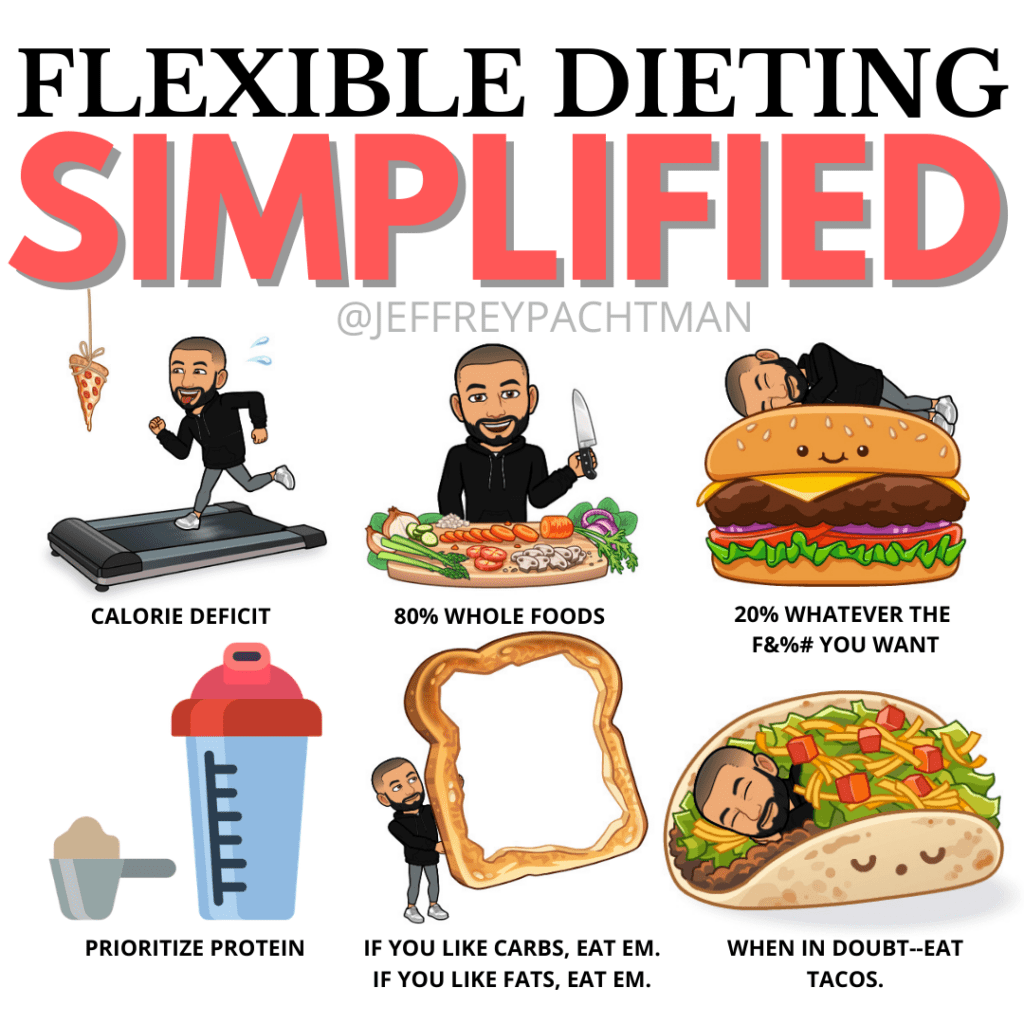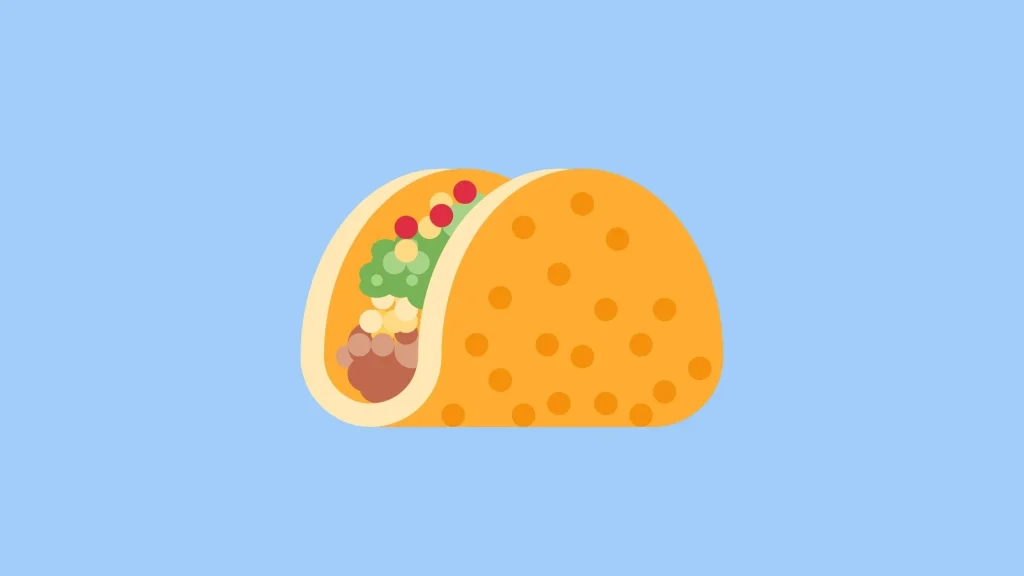This will be one of the most comprehensive yet simple guides to get you started on your flexible dieting journey.
In this guide, I am going to show you six simple rules of flexible dieting.
Excited?
Cool. Let’s get into it.
But first…
I have a favor to ask of you:
I need you to grab a cup of coffee, put your phone away, and really FOCUS. I mean REALLY FOCUS. I want you to read every syllable, and truly apply what I am going to teach you today.
Alright? Deal.
In order to start this guide to the six simple rules of flexible dieting, we first have to define what flexible dieting is.
What is flexible dieting?
Flexible dieting is a weight loss plan that was developed in the early 2000s, and popularized by a sports nutrition authority named Lyle Macdonald.
The theory of flexible dieting is that as long as a food fits within your specific macronutrient, micronutrient, and fiber targets, it is allowed.
What it is and what it isn’t!
“Unfortunately, flexible dieting has gotten a bad rap as a diet for people who only eat “junk.” That is not the point of flexible dieting. The point of flexible dieting is consistency. Diets fail because people can’t be consistent. They try to diet forever and inevitably gain all of the weight back. Studies show that diets have an almost 95 percent failure rate for long-term weight loss because people can’t maintain whatever lifestyle they used to diet the weight off.”
-Layne Norton
Quick Tips From Lyle Macdonald
- First realize that taking a flexible approach to dieting does not mean eating whatever and whenever you want. If your goal is fat loss or even health, being flexible (as opposed to rigid) simply means not taking the typical black/white, either/or, good/bad approach to dieting.People think in terms of foods as either diet or non-diet, good or bad and that’s a rigid approach. Adoption of flexible dieting attitudes, that is realizing that a single deviation from the diet doesn’t mean that you’re a failure or that the diet has failed, and that almost any food, within limits, can be included on a diet is the key to flexible dieting.
- A second important tip is to realize that, no matter how rabid a lot of people are about flexible dieting, it’s not perfect for everyone. Dieting takes practice and folks who are often in the early stages of flexible dieting often find that a given flexible strategy throws them off the rails or doesn’t work for them. In that case, use it as a learning experience.
- No approach is optimal for everyone and people tend to see any mistake as a failure in themselves. I’d say try any specific flexible dieting strategy three times, making adjustments based on whatever went “wrong” the first or second time and if it’s still not working, abandon it. A little ways down the road, when new habits have become more entrenched, they can be tried again.”
By the way, if you want some of the most comprehensive literature written on this subject, Lyle’s Flexible Dieting book is an amazing read.
Why Most Diets Fail
One of the biggest downsides I see of most dieting approaches is their tendency to label foods as “good” or “bad”.
The problem with allowing one food while you are “dieting” and another while you are not, is unhealthy from a psychological perspective.
For example:
Keto = Carbs are bad, fats are good.
HCLF = Fats are bad, Carbs are good.
Whole 30 = Dairy, sugar, and processed foods are off-limits.
Paleo = Avoid grains or any processed foods.
Flexible Dieting = No food is good or bad. No food is off-limits. However, it must fit into your macros, fiber, and micronutrients.

Six Simple Rules of Flexible Dieting:
1. Energy Balance
If you are looking to lose some body fat, you will want to be in a calorie deficit. This means eating fewer calories than your body burns.
When are looking to gain some muscle, you must be in a calorie surplus. This means eating more than your body burns.
Here’s a free calculator that will show you a good starting point if you want to lose some fat.
In order to lose body fat, we HAVE to be in a calorie deficit. If you have been following my page for any amount of time, you know this.
So how do we know if we are in a calorie deficit?
We don’t…At first.
If you are losing 0.5-1lbs per week on average, that is a great place to start. If you are losing more than that, you may need to increase calories a bit. If you are losing less than that, you may want to decrease them.
It’s always a guessing game, so it may be smart to start tracking your normal diet now, and then slowly take some calories out, and see what happens.
2. 80% whole foods
I think flexible dieting gets a bad rap. People think it’s all about eating like a complete shithead as long as you are in a deficit.
However, we still should always aim for eating 80% of our diet from fruits, vegetables, lean proteins, grains, etc…
This makes sure you are getting all of your micronutrients and fiber to keep you happy and healthy.
We want to make sure you are getting some quality nutrition and not just eating pop tarts (the favorite food of all IIFYMers).
3. 20% Whatever the f&*% you want
Have your cake and eat it too. Literally.
This is where you have some pop tarts.
Or if you’re smart, TACOS.
If you can hit your calories, protein, fiber, and micronutrient goals, you can always sneak in some ice cream, pizza, etc…whatever is going to help you not feel so deprived.
Dieting should not feel like a prison. It should feel like you are slightly hungry. You may have to trade in some of your favorite foods for slightly lower-calorie versions sometimes, but overall, you should still be able to fit some “fun foods” into your diet on a pretty regular basis.
4. Prioritize protein
You need a lot of protein. I mean A LOT.
30-40% of your total calories.
Not only does it help reduce cravings and night snacking, but it also helps you retain or build muscle while in your deficit.
So how much is enough exactly?
This really depends on your body fat percentage and training level.
If you are a well-trained individual with a healthy body fat percentage, 1g/lb of bodyweight should be plenty.
If you are at a body fat percentage above 20%, you can eat closer to 1g per pound of goal body weight.
PS: I also wrote a pretty awesome blog on High Protein Snacks.
5. If you like carbs, eat em. If you like fats, eat em.
You should not have to limit carbs or fats, or even worry about them at all. Fats however are essential, so you should aim for at least 20% if your calories from healthy fats.
Lately, there has been this carbs vs. fats battle.
You have your MCT oil splashing, electrolyte fasting keto dieters vs. your fruit gorging, rice-ingesting high carbs.
I think there is a middle ground, and both should be implemented in a solid nutrition protocol.
Fats are essential for many different hormonal functions, and should definitely be brought into the conversation, whereas carbohydrates should be a filler to fill in the rest of your calories after adequate protein and fat macronutrients consumption.
Carbs are great fuel for training, and you will have some pretty amazing morning training sessions after a nice chicken and rice bowl the night before.
6. When in doubt—eat tacos
Just chill the f*&% out and have some tacos. Because tacos are life.
Did you enjoy this guide to the six simple rules of flexible dieting? Drop a comment or a question below!
Til next time,
JP.

